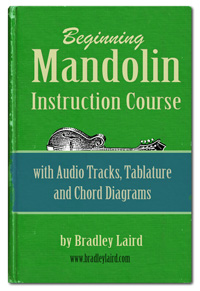|
HOME | FREE MANDOLIN CHORD CHARTS | FREE VIDEO LESSONS | FREE PODCAST FOR STUDENTS FREE BEGINNING MANDOLIN LESSONS | FREE MANDOLIN TABS | BRAD'S eBOOKS |
||||
Get
Brad's mandolin books and free newsletters
here.. 
©2020 Bradley Laird |
FREE
MANDOLIN LESSON 13 - by Bradley Laird
THE
LOGICAL LAYOUT OF THE MANDOLIN Here we see an A major scale starting on the second string. In the second measure we have the exact same fingering--just moved down so that it starts on the third string. This simple movement gives us the D major scale. The third measure carries this idea down to the fourth string where we get a G major scale with the exact same relative finger movements.
Using this understanding, it should be obvious that if you have a tune in the key of A, and you are playing the second and first strings, you could just move it down one string and have the very same tune in the key of D. Bring it down one more string and you are playing it in the key of G. Try this with the first version of Boil Em Cabbage Down that you learned earlier. Next, take a look at the tablature below and notice the similarity between the first two measures (a D major scale) and the last two measures (a D# major scale.)
Simply by adding 1 to all of the numbers we have raised the entire passage up a half step or, you could say, we have "sharped" the key. Here is the song Boil Em Cabbage Down the way we learned it in the key of A
Now, here I have simply added 1 to every number in the tablature. This puts the entire tune in the key of A#. (A# is also called B-flat.)
Try playing that! Really! It's not that hard to do. You have to use more of your left hand fingers but this is really a great introduction to playing up the neck. You'll thank me later by trying this now! The act of moving a song from one key to another is called transposing. Notice how, in the next to last note of the next to last measure, I did not add 1 to that number! It WAS a 6th fret note in the key of A. Moving it up by 1 would have made it a 7th fret note, which is the same note as the open string above it, so I just used the open string to simplify the playing of the note. These basic navigational concepts are often overlooked or seriously delayed in most beginning mandolin books. I think it is important that you learn these basic concepts early in your mandolin playing! If you want to really get into more of this stuff please take a look at my book "Mandolin Master Class." I think you'll be glad you did! If you doubt me, read what other people have said about it here. While you are here, I might as well confess that my motivation in providing these free lessons is two-fold: First, I want you to buy my books and video lessons. I am sure you figured out that obvious motive by now. I figure I that I might also make enough money to buy a couple of sets of strings and maybe, with luck, earn more than the cost of the web server space. Second, is to help you avoid some of the frustration that I faced when I was first learning--back when the Wooly Mammoth roamed the earth -- by getting some important things straight in your mind early in the process. Always remember that the idea is to learn to play the instrument, not to play "some song" on the instrument. At least that's what I believe. I hope you are having fun so far! Let's move on to Lesson 14.
| |||







